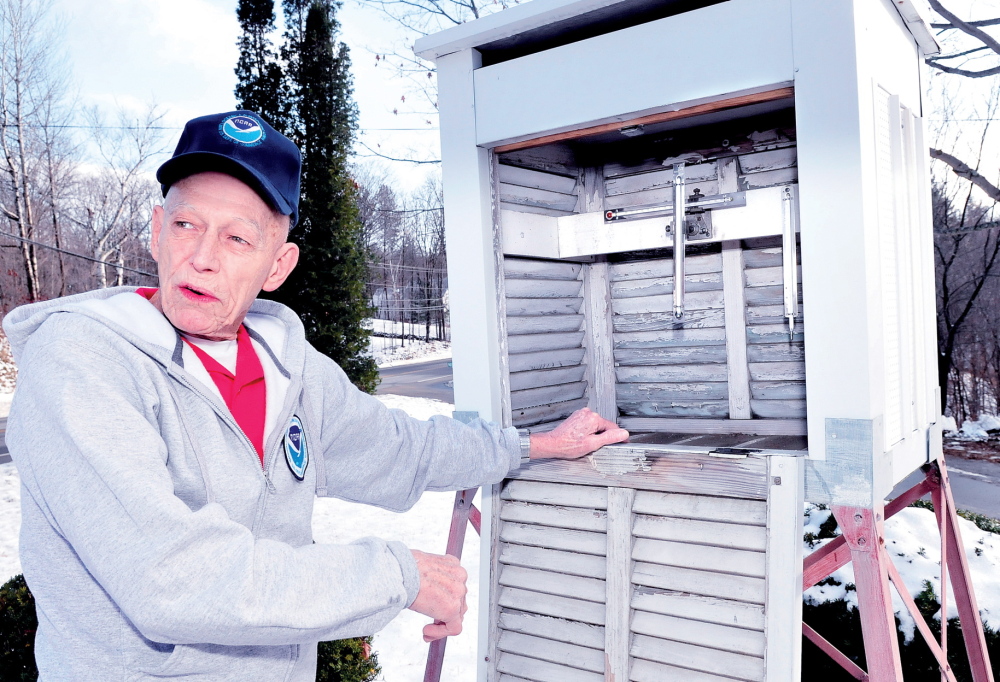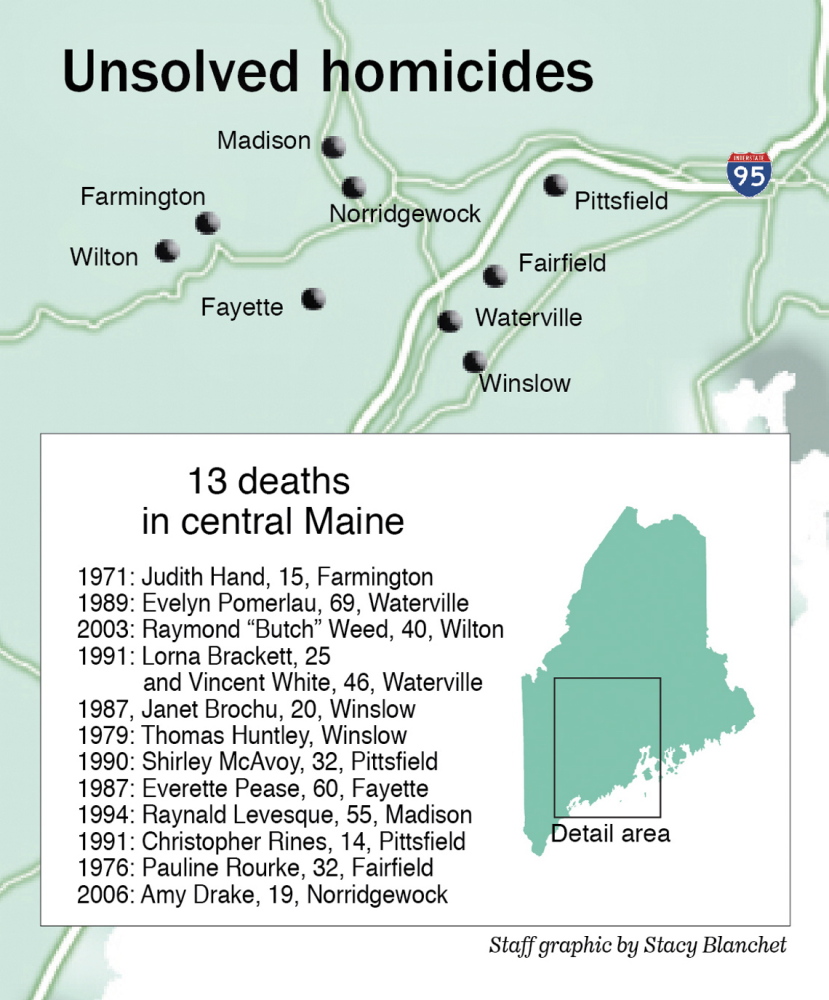First of two parts
Mention the name – Judith Hand – and he sighs.
“There is scarcely a day that I don’t still reflect on that tragic case,” Dennis Pike says.
In 1971, when Pike heard Hand’s name for the first time as a young Farmington police officer, the world seemed much more innocent.
In those days, beginning in the mid-1960s, Pike patrolled the region’s roads and highways, eventually rising in the ranks to become sheriff of Franklin County, a position he held until 2012.
Today, Pike is 75, small but well-postured, mostly bald, his face lined with creases. Pike spends his time catching up on backlogged home projects, which for five decades always seemed to take a back seat to the latest crime or crisis.
Pike is a firm believer in justice, and that’s why the day they discovered Hand’s body, 43 long years ago, has burned so brightly in his memory.
People call unsolved murders such as Hand’s “cold cases,” but it’s a loosely defined concept. An online database maintained by the Maine State Police has 68 names on it dating back to 1970, but that tells only part of the story. Adding deaths and missing-persons cases that are considered suspicious brings the total to 120 – just a tiny slice of an estimated 200,000 unsolved murders nationwide.
Among 13 cases from central Maine in the online database, Judith Hand’s is the oldest.
In April, legislators passed “An Act to Create a Cold Case Unit in the Department of the Attorney General,” but the Appropriations Committee did not fund it, drawing harsh criticism from supporters. Now, members of the state’s justice system and relatives – some of them haunted by the thought that the person who killed a loved one remains at large – are anxiously awaiting word on a federal grant that could help some of them to achieve some form of closure.
Pike calls Hand’s case the biggest disappointment of his career. There are certain details he would prefer not to discuss, saying they might upset surviving members of the Hand family, but that doesn’t mean he doesn’t remember them.
“I was in Augusta, doing a polygraph on another suspect,” Pike said of that fateful September day. “While we were there, the state police officer who was doing that got a note and handed the note to me. It said they had discovered the remains of Miss Hand. ”
On Sept. 10, 1971, after Judith came home from a day’s classes at Mt. Blue Junior High School, the 15-year-old went back out, traveling by foot.
Blond, hazel-eyed and petite, Judith was walking to a baby-sitting job where she hoped to earn a little money to give to her parents, who were struggling financially.
Her father, a house painter, had been out of work for a year with medical problems, leaving the family unable to provide easily for Judith and her eight siblings.
“It was a large family,” Pike says. “I knew, certainly, her brothers. She had never been in any type of trouble. I probably had seen her with her brothers, and I knew her father and mother.”
Their mother, Lillian Hand, told reporters that of all the children, Judith was the most, the least likely to get into a car with a stranger.
Yet police believe Judith was taken in broad daylight less than a mile from her home.
She never arrived at her baby-sitting job, which was at the home of a relative. The disappearance wrested the public’s attention away from the ongoing Farmington Fair. Her family, though poor, offered a large reward for information leading to an arrest. A frantic search ended nearly two weeks later off High Street. Today, the property houses the University of Maine at Farmington’s Health and Fitness Center. Back then, it was a family-owned sawmill.
“They shot their sawdust from years of sawing into the southeast corner,” Pike said, “and it was in that particular accumulation of sawdust that the dogs did in fact locate the body. It had been there some time, and the sawdust was wet. That generates heat.”
The conditions had accelerated the decomposition of the body, making it more difficult to use as evidence.
During the ensuing investigation, police officers interviewed hundreds of people. Two people confessed to the murder, but their confessions were ruled out as falsified.
Weeks passed, then months – then decades.
Larry Hand, Judith’s brother, is one of many who supports the funding of a dedicated cold case unit that would work full time on solving murder cases that have continued to confound the efforts of homicide detectives.
COLD CASES
In central Maine, the bodies of the victims can turn up anywhere, the signs of violence varied.
The corpse might be submerged in Pittsfield’s Mill Pond. Buried in a pile of sawdust in Farmington. In a little-traveled spot in the woods of Norridgewock. Slumped in the hallway with two bullet wounds in Wilton. In the living room of a burned home, charred but still identifiable. Nude, badly decomposed and algae-covered in the Sebasticook River. Wrapped in a quilt in Spotsylvania, Va. Lying in bed in a pondside camp in Fayette.
Taken as a group, they constitute a gory heap of evidence of the dark side of humanity.
“Basically,” Pike said, “if I were the Almighty, I wouldn’t be particularly pleased with my efforts.”
What the cold cases have in common is that their killers have not been convicted. Each one leaves a black stain on the reputation of the state’s law enforcement division.
Despite the stack of cold cases, Maine has been and remains a safe state to live in. Statistically, the odds of being the victim of a violent crime of any type is one in a thousand, significantly less than the four per 1,000 violent crime rate of the nation as a whole.
With a population of 1.3 million people, Maine had 26 homicides in 2012 and another 25 in 2013.The large majority of those murders – 90 percent or more – are solved during the first active investigation by law enforcement officers. Often the killer is obvious – a 2009 report by the FBI found that of 7,650 murders committed in that year, 4,119, or 54 percent, were committed by friends or acquaintances and another 1,855, or 24 percent, were committed by family members, finite groups of suspects that can be ruled in or out easily. Only 1,676, or 22 percent, were committed by strangers.
When charges aren’t filed quickly, public interest fades and time passes, making the going more difficult for investigators. The chances of solving a murder dwindle with the decades.
As new cases begin to pile up, law enforcement officials bump up against a resource problem.
It’s the oldest story in the world, according to Deputy Attorney General William Stokes.
“That’s money,” he said.
In order to make killers pay for their crimes, a society must pay for a well-resourced criminal justice system, Stokes said.
And in Maine, when it comes to a dedicated cold case unit tasked specifically with tracking down Hand’s murderer, legislators have not found the money.
MURDER IN A BOX
The state’s answer to murders, along with other suspicious deaths and child abuse, is the Major Crimes Unit. Its six sections are staffed by a total of 27 detectives, often considered to be the best investigators in the state.
Detective Sgt. Jason Richards of the Maine State Police oversees four detectives who constantly work cases in Knox, Waldo and Somerset counties.
When a murder first breaks, the detectives talk about it as if it’s a physical thing that has barged into their offices and occupies space.
Such cases “come in the front door,” Richards said.
Most cases are solved quickly. Detectives solve 29 percent of murders within a day and 50 percent within a week, according to a study from the Justice Research and Statistics Association. An additional 38 percent are solved between the first week and the end of six months. Only 3.9 percent take more than a year to close.
As the months begin to add up, the chances of closure go down, according to a 2008 statistical analysis by Cleveland State University, which found that “the probability of case clearance markedly declines with the passage of time. In fact, these analyses suggest that homicides go cold as soon as two weeks after the case becomes known.”
In the Hand case, at some point investigators reluctantly packed the evidence away into a box and began referring to it as a cold case.
Richards doesn’t like the term.
“These cases do get looked at,” he said. “These cases are never cold, as far as our unit is concerned.”
It might seem strange that what started as an act of criminal violence, alive with motion and sound and high emotion, becomes, in the hands of law enforcement officers, something that can be put into a box.
Once the crime scene has been analyzed and the witnesses have given their statements, a large cardboard box becomes the central repository for all the information that can help lead to prosecution.
MAINE SYSTEM UNIQUE
No state or federal office has established a universally agreed-upon method for handling cold cases.
“I have researched this nationwide, and I can tell you that the way cold cases are worked are as unique as the agencies that work them,” Richards said.
Maine’s system, he said, is attentive to the cases given limited resources.
Within the Major Crimes Unit, each detective is given somewhere between two and four boxes. Inside each box is a death, unsolved.
The strength of this system is that every murder is assigned to someone who gets familiar with the case and can weigh the important of new evidence.
But there’s also a problem.
Even though the murder rate in Maine has remained constant, the workload of the Major Crimes Unit, which also investigates other types of deaths and child sexual assaults, keeps growing.
The cold cases don’t take priority over the more timely cases.
But even then, the cardboard boxes don’t collect dust, Richards said.
When a detective has time, he or she sifts through the materials inside, looking for hope. Maybe a witness has gone through a divorce, which might make it more likely that person would testify against the former spouse. Maybe a new investigative technique can be applied to a piece of physical evidence. Maybe a new insight will open an entirely different line of questioning that would justify spending time to interview a new set of witnesses.
Maine is unusual in that only two cities – Portland and Bangor – have their own homicide units, with all other murders throughout the state falling to the Major Crimes Unit. This has led to an unusually centralized system for handling cold cases.
Four times a year, a group gathers to talk about the cold cases. It includes a supervisor from the crime laboratory, someone from the medical examiner’s office, and representatives from the Major Crimes Unit and the attorney general’s office. It also includes the homicide divisions of Bangor and Portland police departments.
In anticipation of these meetings, detectives in the unit are asked to review their cases for possible presentation to the group. If the detective thinks there is a lead worth following up on, he or she makes an argument for why that particular case should be given priority for expended resources.
The system essentially pits cases against each other in a competition to determine which ones might, if given an investment of time and money, pay off in a prosecution.
Richards is proud of the system, which he said might be unique.
“I haven’t found anything nationwide that has a systematic way of doing this like we have,” he said.
But the system is also slow.
“Probably our biggest hindrance is that our detectives have to work these when they can find time in between the current cases,” Richards said.
And it’s not just the lead detective. The entire justice system is geared toward handling more recent cases, again because of resource issues.
“The big thing is finding a chemist or DNA analyst who has time to go through this evidence,” Richards said. “They have the same constraints we do when they’re working active cases. When they have time, they can look at it.”
As a result, Richards said, “it can take us months or even years to get it through the lab and get it documented.”
The passage of time hurts a case. The chance of solving deteriorates.
DOGGED INVESTIGATION
Seventeen years after Judith Hand’s 1971 death, her murder snapped back into focus for the public.
In 1988, a Farmington police officer and three detectives from the state police actively took up the investigation again, following up on new leads. Six months later, in 1989, police told reporters the investigation was once again slowing down.
Twelve more years went by.
In 2001, the Hand case became part of a larger national story involving a Massachusetts-based father-and-son team suspected of raping and murdering a number of young women and girls across the Northeast in 1971 and 1972. In Maine, they were suspects in the murders of Alice Lothrop, of Cape Elizabeth, whose body was found in 1972; and Mary Olenchuk, who was killed in Ogunquit in 1971, as well as Hand. Investigators from Maine, Massachusetts, New Hampshire and New York met in Portland to discuss the connections among the cases and to see whether they could help each other.
In 1972 Raymond Trimmer and his teenage son, Raymond Parsons, were arrested in connection with the rape of a 12-year-old girl from Tewksbury, Mass. Parsons, then 16, was convicted of the Tewksbury rape and at least one other rape and assault, and he was sentenced to Bridgewater State Hospital, Massachusetts’ state institution.
Trimmer was not prosecuted for any of the crimes, but he was convicted subsequently of attempted rape in 1973 and again for assault in 1978. In 2002, Trimmer was sentenced to serve up to 11 years for living under a false name and illegally collecting Social Security benefits as a cook at a Massachusetts country club. At age 72, he lost his 2006 appeal of that conviction in New York state’s Supreme Court.
Parsons is now 58 years old and incarcerated as a level-three sex offender, meaning that he is considered to be at high risk to reoffend. Did either man kill Judith Hand? No one in law enforcement can say for sure.
Richards, speaking only in a general sense, said there are times when police believe they’ve identified a killer but lack the evidence needed to prosec
But the law has not forgotten her. One sign of that is the news that Judith Hand’s case has been discussed recently during Maine’s quarterly review process.
“I can tell you that case has been through that review recently to identify areas that can be worked,” Richards said.
Copy the Story LinkSend questions/comments to the editors.





Success. Please wait for the page to reload. If the page does not reload within 5 seconds, please refresh the page.
Enter your email and password to access comments.
Hi, to comment on stories you must . This profile is in addition to your subscription and website login.
Already have a commenting profile? .
Invalid username/password.
Please check your email to confirm and complete your registration.
Only subscribers are eligible to post comments. Please subscribe or login first for digital access. Here’s why.
Use the form below to reset your password. When you've submitted your account email, we will send an email with a reset code.